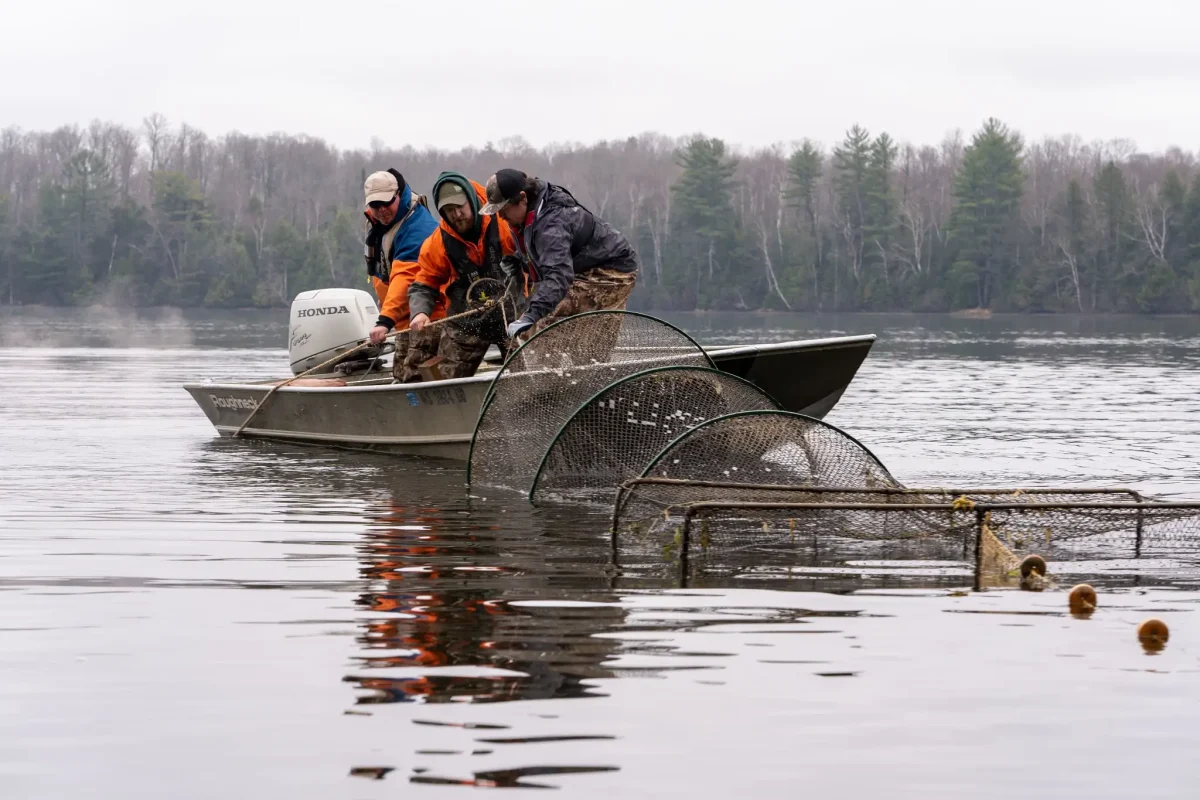Wisconsin lakes have been thawing at record-breaking dates this year, affecting the spawning cycle of Wisconsin’s walleye, a keystone species whose absence has economic, cultural and environmental repercussions.
The walleye, a member of the perch family, is the state fish in multiple midwestern states — Minnesota, Ohio and South Dakota. Walleye are not only fished for game, but are a hugely popular food source in many homes and restaurants, according to the University of Wisconsin Center for Limnology.
Increasingly warm and variable temperatures pose a large threat to the walleye population in Wisconsin because their spawning is triggered by ice thawing on lakes, UW Center for Limnology fisheries scientist Zachary Feiner said.
The state of Wisconsin recorded one of the earliest ice-out dates in history this year, with the ice duration on Lake Mendota clocking in at only 44 days, compared to the historical average of 102 days. The average duration has been shortening over time, with an average over the last five-years being 82 days, according to the Wisconsin State Climatology Office website.
When the ice recedes on lakes, the influx of sunlight and warmer waters in the water column spur the growth of small photosynthesizers called phytoplankton and their predators — zooplankton animals, Feiner said. These zooplankton are the main food sources for young walleye, but when the ice duration shortens, there is a mismatch of walleye egg hatching and zooplankton abundance, leaving the young fish without any food.
Extinguished walleye populations have a rippling effect on other aquatic animal populations. Walleye are known as a keystone species in most Midwestern lakes, according to UW Sea Grant Institute fisheries specialist Titus Seilheimer. They are at the top of the food chain in many lake ecosystems like Lake Mendota, so a change in their population would have a domino effect on the entire dynamic of a lake.
Specifically, a decrease in walleye populations will lead to less predation of their primary food source — small fish. This shift will stimulate the growth of an oversized population of smaller fish, which consume zooplankton. When more of these fish are present, they will deplete the zooplankton population, which feed on algae. A lack of algae-eating plankton will result in an overabundance of algae in lakes, resulting in increased algal biomass that blocks sunlight to other water plants — altering aquatic vegetation and habitat.
A decrease in walleye populations would not only be detrimental to future generations of walleye, but would also have a large economic effect. Walleye is the most important species for game fishing in the state of Wisconsin, with local lakes welcoming tourism from all over the Midwest, Feiner said.
Northwestern Wisconsin receives huge masses of visitors for walleye game fishing every spring and summer, supporting the local economy through purchases at bait shops, restaurants, lodging and fish guides. A decline in any of these facets would cause a large economic hit in small Wisconsin towns, Feiner said.
Seilheimer said a changing climate influences population abundance in lakes too, resulting in walleye-dominant lakes slowly turning into bass-dominant lakes.
“We’ve got a warming climate, we’re seeing our lakes warm and that generally favors bass over walleye,” Seilheimer said.
For communities dependent on walleye, this transition can be difficult to navigate. Bass are not eaten as frequently as walleye, so a shift within these lakes would remove a large food source, Seilheimer said.
Feiner said the Wisconsin Department of Natural Resources performs creel surveys each year — a type of survey for anglers that consists of interviews with fisher people about what they are fishing for and how many hours they spend fishing.
“Anglers spend the most time fishing for walleye than any other species,” Feiner said. “They are number one in our sport fish community in terms of the time spent by anglers and the resources, the money spent by anglers and pursuing fish.”
Walleyes also play an important cultural role in the Midwest. Northern Wisconsin is known as the Ceded Territories, which include 913 walleye lakes, according to the Milwaukee Public Museum website. This territory was ceded to the federal government by the Ojibwe tribes in 1837 and 1842, while granting Ojibwe tribes to fish, forage and hunt off of reservation land.
For the Ojibwe tribes in northern Wisconsin, walleye are their largest food source, according to Feiner. They are the first food source of the spring, so walleye fishing is seen to be indicative of kicking off a strong hunting season, Feiner said.
The cultural and ceremonial importance of walleye for Ojibwe peoples has spawned conflict when their sovereign rights to gathering fish were threatened by restrictive state laws. The resulting Wisconsin Walleye War in the late 1900s was a legal battle in which the Ojibwe people fought for their treaty rights to fish and hunt and were ultimately successful.
“When you think about it, walleye is arguably the most important [Wisconsin] fish species to this day,” Feiner said. “When it comes to recreational importance, economic importance and traditional and cultural importance for all of our residents.”










